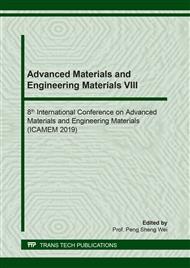[1]
Peng L, Feng Y Y, Zhang X Q, et al. Recent progresses in application of functionalized graphene sheets[J]. Science China Technological Sciences, 2010,53(9):2311-2- 319.
DOI: 10.1007/s11431-010-4050-0
Google Scholar
[2]
Pinto A M, Gonçalves I C, Magalhães F D. Graphene-based materials biocompatibility: a review.[J]. Colloids & Surfaces B Biointerfaces, 2013, 111(6):188-202.
DOI: 10.1016/j.colsurfb.2013.05.022
Google Scholar
[3]
Novoselov K S, Geim A K, Morozov S V, et al. Electric field effect in atomically thin carbon films.[J]. Science, 2004, 306(5696):666-669.
DOI: 10.1126/science.1102896
Google Scholar
[4]
Zhou Qi,Zhong Yonghui,Chen Xing,et al.Preparation and photocatalytic properties of graphene/nano TiO2 composites [J].Acta Materiae Compositae Sinica,2014, 31- (2):255-262.(in Chinese).
Google Scholar
[5]
Geim A K, Novoselov K S. The rise of graphene[J]. Nat-Mater.,2007,6:183-191.
Google Scholar
[6]
Gao W, Alemany LB, Ci LJ, et al. New insights into the structure and reduction ofgraphite oxide[J]. Nature Chemistry ,2009,1(5):403-408.
Google Scholar
[7]
Singh V,Joung D,Zhai L,et al.Graphene based materials: Past, present and future[J].Progress in Materials Science,2011,56(8):1178-1271.
DOI: 10.1016/j.pmatsci.2011.03.003
Google Scholar
[8]
Kuilla T, Bhadra S, Yao D, et al. Recent advances in graphene based polymer composites[J]. Progress in Polymer Science, 2010,35(11):1350 -1375.
DOI: 10.1016/j.progpolymsci.2010.07.005
Google Scholar
[9]
Gui D, Miao X, Zeng G, et al. Preparation and thermal stability of amine-terminated polyesteride modified epoxy resin[J]. Journal of Materials Science Materials in Electronics, 2013, 24 (1- 1): 4614-4620.
DOI: 10.1007/s10854-013-1452-3
Google Scholar
[10]
Yu J, Huo R, Wu C, et al. Influence of interface structure on dielectric properties of epoxy/alumina nanocomposites[J]. Macromolecular Research, 2012, 20(8):816-826.
DOI: 10.1007/s13233-012-0122-2
Google Scholar
[11]
Guo Y, Bao C, Song L, et al. In Situ Polymerization of Graphene, Graphite Oxide, and Function Functionalized Graphite Oxide into Epoxy Resin and Comparison Study of On-the-Flame Behavior[J]. Ind.eng.chem.res, 2011, 50(13):7772-7783.
DOI: 10.1021/ie200152x
Google Scholar
[12]
Ahmadi-Moghadam B, Sharafimasooleh M, Shadlou S, et alEffect of functionalization of graphene nanoplatelets on the mechanical response of graphene/epoxy composites[J]. Materials & Design, 2015, 66:142-149.
DOI: 10.1016/j.matdes.2014.10.047
Google Scholar
[13]
McAllister MJ, Li J-L, Adamson DH, Schniepp HC, Abdala AA, Liu J, et al. Single sheet functionalized graphene by xidation and thermal expansion of graphite. Chem Mater 2007; 19(18): 4396–404.
DOI: 10.1021/cm0630800
Google Scholar
[14]
Park S, Ruoff R S. Chemical methods for the production of graphenes. [J]. Nature Nanotechnology, 2009, 4(4):21- 7.
Google Scholar
[15]
Teng C C, Ma C C M, Lu C H, et al. Thermal conductivity and structure of non-covalent functionalized graphene/epoxy composites[J]. Carbon, 2011, 49(15): 5107-5116.
DOI: 10.1016/j.carbon.2011.06.095
Google Scholar
[16]
Liao R, Tang Z, Lei Y, et al. Polyphenol-Reduced Graphene Oxide: Mechanism and Derivatization[J]. Journal of Physical Chemistry C, 2011, 115(42):20740-20746.
DOI: 10.1021/jp2068683
Google Scholar
[17]
Qi XY, Yan D, Jiang ZG, Cao YK, Yu ZZ, Yavari F, et al.Enhanced electrical conductivity in polystyrene nanocomposites at ultra-low graphene content. ACS Appl Mat Interfaces 2011; 3(8): 3130–3.
DOI: 10.1021/am200628c
Google Scholar
[18]
Wang X, Xing W, Zhang P, Song L, Yang H, Hu Y. Covalent functionalization of graphene with organosilane and its use as a reinforcement in epoxy composites. Compos Sci Technol 2012; 72(6): 737–43.
DOI: 10.1016/j.compscitech.2012.01.027
Google Scholar
[19]
Rafiee M A, Rafiee J, Srivastava I, et al. Fracture and Fatigue in Graphene Nanocomposites[J]. Small, 2010, 6(2):179-183.
DOI: 10.1002/smll.200901480
Google Scholar


